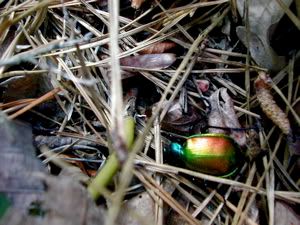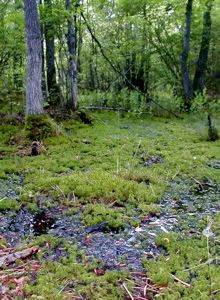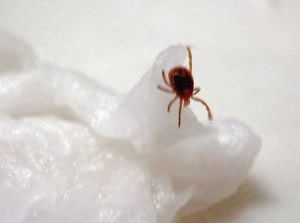(no subject)
This morning it was cloudy and cold again.
I was at the Jersey Shore and would have liked to go to the beach.

However, the weather seemed more appropriate for an inland hike instead.
Off to Brendan T. Byrne State Park forest!

The trailhead closest to the parking lot was the Cranberry trail.
This region used to be known for growing cranberries and highbush blueberries before "the face of agriculture changed" in New Jersey.

At first I was started when this Rainbow Leaf Beetle ran across the trai
l--then I chased him into the brush to take his photograph. Lovely little thing.

The Rainbow Leaf Beetle (Chrysolina cerealis) is a species of leaf beetle (Chrysomelidae) with sixteen British species which feed on wild thyme and mints. (Probert Encyclopedia, I did my homework!)
The swampy land was the draw for berry farmers back in the day.

Besides berries, sphagnum moss grows like crazy here. Apparently it can absorb many times it's weight in water and was used to dress wounds in WWI and used in diapers by Native Americans. Thanks for the info trail-side sign!

A captivating reflection in the tea-colored water, dyed by cedar wood.
It smelled wonderful, too!

I was amused by this warning from the Environmental Protection Agency about the area infested with deer ticks carrying lyme disease.

I took heed and tucked my pants into my socks and avoided walking in tall grasses and shrubbery.

On with the hike!

So wonderful. I'm so glad I went.
However, I kept thinking things that I would have liked to have commented on to a companion.
No companion. That's why I'm blogging about this, I suppose.
Now you all can be my companion.

When I got back to my dad and step-mom's we had supper and then I hopped int he shower.
Lo and behold! I had brought a dreaded deer tick home on my left shin!!!
So much for tucking in my pant legs...

I have to admit, I freaked out a little when I found this little guy sucking my blood, his head buried under my skin.
Mostly I was freaked out about getting lyme disease.
I took her photograph (The female is bigger, and if I remember the scale of the warning poster, this one is big) and then flushed her, by my step-mom's recommendation.
Even though I checked my body carefully for more ticks and did not find any, every time I feel my hair or clothes brush my skin the wrong way I freak out a little. I've become paranoid about tiny bloodsuckers. I hope the paranoia doesn't last long. It's annoying.
Then I consulted Web MD.
What is Lyme disease, anyway?
Lyme disease is an infection that is spread by ticks. You can get Lyme disease if you are bitten by an infected tick. But most people who have had a tick bite do not get Lyme disease. It’s still important to see your doctor if you have a tick attached to you that you can't remove.
Lyme disease is common in the United States. It can also be found in Canada, Europe, and Asia.
What causes Lyme disease?
Lyme disease is caused by bacteria. Infected ticks spread the bacteria by biting people or animals.
Two types of ticks carry the Lyme disease bacteria in the U.S. They are:
What are the symptoms?
One sign of Lyme disease is a round, red rash that spreads at the site of a tick bite. This rash can get very large.
Flu-like symptoms are also very common. People in the early stages of Lyme disease may feel very tired and have headaches, sore muscles and joints, and a fever.
These symptoms can start at any time, from 3 days up to a month after you have been bitten. Some people don't have any symptoms when they are in the early stages of Lyme disease. And they may not even remember getting a tick bite.
If Lyme disease goes untreated, you can have more serious symptoms over time. These include:
Your doctor will ask you questions about your symptoms. A round, red rash may be a sign of Lyme disease. Your doctor will also ask about your activities to try to find out if you have been around infected ticks. You may have a blood test to see if you have certain antibodies in your blood that could mean you have the disease.
How is it treated?
The main treatment for Lyme disease is antibiotics. These medicines usually cure Lyme disease within 3 weeks of starting treatment.
It’s important to get treatment for Lyme disease as soon as you can. Talk to your doctor if you have had a tick attached to your skin, especially if you live in an area where Lyme disease has been reported. Look for early signs of the disease, such as a round, red rash that gets bigger or symptoms like those you'd get with the flu.
If it goes untreated, Lyme disease can lead to problems with your skin, joints, nervous system, and heart. These can occur weeks, months, or even years after your tick bite. The problems often get better with antibiotics, but in rare cases they can last the rest of your life.
Can you prevent Lyme disease?
The best way to prevent Lyme disease is to protect yourself from ticks. Cover up as much skin as you can when you're going to be in wooded or grassy areas. Wear a hat, a long-sleeved shirt, and long pants with the legs tucked into your socks. And keep in mind that it’s easier to see ticks on light-colored clothes.
Use a bug spray that has the chemical DEET to repel ticks. You can spray it right on your skin. Check your pets for ticks after they've been outside. You can't get Lyme disease from your pet. But your pet can bring infected ticks inside. These ticks can fall off your pet and attach to you.
------
So I got her off perhaps soon enough to avoid infection if my little pal was indeed carrying lyme disease. I put antibiotic ointment on the bite site. I guess I wait to see if I get a rash...
____
PS I am finally driving home to Elk Grove on Friday (too late not to stop and try to see people I was going to), back to Harris, Iowa Saturday, Sioux Center on Sunday and back to Elk grove on Monday with a stop in Madison both there and back if all goes as planned.
I was at the Jersey Shore and would have liked to go to the beach.

However, the weather seemed more appropriate for an inland hike instead.
Off to Brendan T. Byrne State Park forest!

The trailhead closest to the parking lot was the Cranberry trail.
This region used to be known for growing cranberries and highbush blueberries before "the face of agriculture changed" in New Jersey.

At first I was started when this Rainbow Leaf Beetle ran across the trai
l--then I chased him into the brush to take his photograph. Lovely little thing.

The Rainbow Leaf Beetle (Chrysolina cerealis) is a species of leaf beetle (Chrysomelidae) with sixteen British species which feed on wild thyme and mints. (Probert Encyclopedia, I did my homework!)
The swampy land was the draw for berry farmers back in the day.

Besides berries, sphagnum moss grows like crazy here. Apparently it can absorb many times it's weight in water and was used to dress wounds in WWI and used in diapers by Native Americans. Thanks for the info trail-side sign!

A captivating reflection in the tea-colored water, dyed by cedar wood.
It smelled wonderful, too!

I was amused by this warning from the Environmental Protection Agency about the area infested with deer ticks carrying lyme disease.

I took heed and tucked my pants into my socks and avoided walking in tall grasses and shrubbery.

On with the hike!

So wonderful. I'm so glad I went.
However, I kept thinking things that I would have liked to have commented on to a companion.
No companion. That's why I'm blogging about this, I suppose.
Now you all can be my companion.

When I got back to my dad and step-mom's we had supper and then I hopped int he shower.
Lo and behold! I had brought a dreaded deer tick home on my left shin!!!
So much for tucking in my pant legs...

I have to admit, I freaked out a little when I found this little guy sucking my blood, his head buried under my skin.
Mostly I was freaked out about getting lyme disease.
I took her photograph (The female is bigger, and if I remember the scale of the warning poster, this one is big) and then flushed her, by my step-mom's recommendation.
Even though I checked my body carefully for more ticks and did not find any, every time I feel my hair or clothes brush my skin the wrong way I freak out a little. I've become paranoid about tiny bloodsuckers. I hope the paranoia doesn't last long. It's annoying.
Then I consulted Web MD.
What is Lyme disease, anyway?
Lyme disease is an infection that is spread by ticks. You can get Lyme disease if you are bitten by an infected tick. But most people who have had a tick bite do not get Lyme disease. It’s still important to see your doctor if you have a tick attached to you that you can't remove.
Lyme disease is common in the United States. It can also be found in Canada, Europe, and Asia.
What causes Lyme disease?
Lyme disease is caused by bacteria. Infected ticks spread the bacteria by biting people or animals.
Two types of ticks carry the Lyme disease bacteria in the U.S. They are:
- Deer ticks They spread the disease in the Northeast and Midwest.
- Western black-legged ticks They spread the disease along the Pacific coast, mostly in northern California and Oregon.
What are the symptoms?
One sign of Lyme disease is a round, red rash that spreads at the site of a tick bite. This rash can get very large.
Flu-like symptoms are also very common. People in the early stages of Lyme disease may feel very tired and have headaches, sore muscles and joints, and a fever.
These symptoms can start at any time, from 3 days up to a month after you have been bitten. Some people don't have any symptoms when they are in the early stages of Lyme disease. And they may not even remember getting a tick bite.
If Lyme disease goes untreated, you can have more serious symptoms over time. These include:
- Swelling and joint pain (like arthritis).
- Tingling and numbness in your hands, feet, and back.
- A lack of energy that does not get better.
- Trouble focusing your thoughts.
- Poor memory.
- Weakness or paralysis in your face muscles.
Your doctor will ask you questions about your symptoms. A round, red rash may be a sign of Lyme disease. Your doctor will also ask about your activities to try to find out if you have been around infected ticks. You may have a blood test to see if you have certain antibodies in your blood that could mean you have the disease.
How is it treated?
The main treatment for Lyme disease is antibiotics. These medicines usually cure Lyme disease within 3 weeks of starting treatment.
It’s important to get treatment for Lyme disease as soon as you can. Talk to your doctor if you have had a tick attached to your skin, especially if you live in an area where Lyme disease has been reported. Look for early signs of the disease, such as a round, red rash that gets bigger or symptoms like those you'd get with the flu.
If it goes untreated, Lyme disease can lead to problems with your skin, joints, nervous system, and heart. These can occur weeks, months, or even years after your tick bite. The problems often get better with antibiotics, but in rare cases they can last the rest of your life.
Can you prevent Lyme disease?
The best way to prevent Lyme disease is to protect yourself from ticks. Cover up as much skin as you can when you're going to be in wooded or grassy areas. Wear a hat, a long-sleeved shirt, and long pants with the legs tucked into your socks. And keep in mind that it’s easier to see ticks on light-colored clothes.
Use a bug spray that has the chemical DEET to repel ticks. You can spray it right on your skin. Check your pets for ticks after they've been outside. You can't get Lyme disease from your pet. But your pet can bring infected ticks inside. These ticks can fall off your pet and attach to you.
------
So I got her off perhaps soon enough to avoid infection if my little pal was indeed carrying lyme disease. I put antibiotic ointment on the bite site. I guess I wait to see if I get a rash...
____
PS I am finally driving home to Elk Grove on Friday (too late not to stop and try to see people I was going to), back to Harris, Iowa Saturday, Sioux Center on Sunday and back to Elk grove on Monday with a stop in Madison both there and back if all goes as planned.